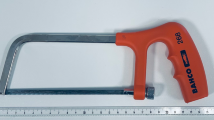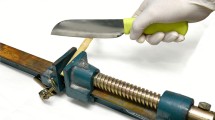Abstract
Postmortem dismemberment results from the use of sharp or sharp blunt instruments. Saws produce specific bone lesions, and the observation of certain saw mark features allows for the recognition of certain characteristics of the saw and its teeth. At autopsy, sections of the skull and other parts of the skeleton are usually achieved using an electrical oscillating autopsy saw. In cases of dismemberment, this autopsy saw may create additional marks to those produced by the criminal activity. In order to help the forensic pathologist to differentiate the two types of marks, this experimental study used a stereomicroscope to examine 130 experimental false starts produced on animal and human bones by an oscillating autopsy saw. A flagrant succession of narrow and wide aspects of the walls (in a “figure of 8” shape), with obvious oval bone islands and undulating striae are patterns typically left behind by oscillating autopsy saws, but the depth of the false starts plays an important role in the variation of the features. In particular, superficial false starts tend to be associated with larger kerf widths, straight walls, and longitudinal bone islands.




Similar content being viewed by others
References
Quatrehomme G (2015) Traité d’Anthropologie médico-légale. De Boeck, Paris
Nogueira L, Quatrehomme G, Rallon C, Adalian P, Alunni V (2016) Saw marks in bones: a study of 170 experimental false start lesions. Forensic Sci Int 268:123–130
Capuani C, Guilbeau-Frugier C, Delisle MB, Rougé D, Telmon N (2014) Epifluorescence analysis of hacksaw marks in bone: highlighting unique individual characteristics. Forensic Sci Int 241:195–202
Pelletti G, Cecchetto G, Viero A, Fais P, Weber P, Miotto D, Montisci M, Viel G, Giraudo C (2017) Accuracy, precision and inter – rater reliability of micro CT analysis of false start bones. A preliminary validation study. Legal Med 29:38–43
Pelletti G, Viel G, Fais P, Viero A, Visentin S, Miotto D, Montisci M, Cecchetto G, Giraudo C (2017) Micro-computed tomography of false starts produced on bone by different hand-saws. Legal Med 26:1–5
Saville PA, Hainsworth RGN (2007) Cutting crime: the analysis of the “uniqueness” of saw marks on bone. Int J Legal Med 131:349–357
Bailey JA, Wang Y (2011) Statistical analysis of kerf mark measurements in bone. Forensic Sci Med Pathol 7:53–62
Porta D, Amadasi A, Cappella A, Mazzarelli D, Magli F, Gibelli D, Rizzi A, Picozzi M, Gentilomo A, Cattaneo C (2016) Dismemberment and disarticulation: a forensic anthropological approach. J Forensic Legal Med 38:50–57
Dogan KH, Demirci S, Deniz I, Erkol Z (2010) Decapitation and dismemberment of the corpse: a matricide case. J Forensic Sci 55(2):542–545
Konopka T, Strona M, Bolechata F, Kunz J (2007) Corpse dismemberment in the material collected by the department of forensic medicine, Cracow, Poland. Legal Med 9:1–13
Konopka T, Bolechala F, Strona M (2006) An unusual case of corpse dismemberment. Am J Forensic Med Pathol 27(2):163–165
Rajs I, Lundström M, Broberg M, Lidberg L, Lindquist O (1998) Criminal mutilation of the human body in Sweden – a thirty-year medico-legal and forensic psychiatric study. J Forensic Sci 43(3):563–580
Delabarde T, Ludes B (2010) Missing in Amazonian jungle: a case report of skeletal evidence for dismemberment. J Forensic Sci 55(4):1105–1110
Bilge Y, Kedici S, Alakoç YD, Ulküer KU, Ilkyaz YY (2003) The identification of a dismembered human body: a multidisciplinary approach. Forensic Sci Int 137:141–146
Di Nuno N, Costantinides F, Vacca M, Di Nunno C (2006) Dismemberment: a review of the literature and description of 3 cases. Am J Forensic Med Pathol 27(4):307–312
Bonte W (1975) Tool marks in bones and cartilage. J Forensic Sci 20(2):315–325
Reichs KJ (1998) Postmortem dismemberment: recovery, analysis and interpretation. In: Reichs KJ (ed) Forensic Osteology, 2nd edn. Charles C. Thomas, Springfield, pp 353–388
Guilbeau MG (1989) The analysis of saw marks in bone. Dissertation, University of Tennessee. Knoxville
Andahl RO (1978) The examination of saw marks. J Forensic Sci 18(1–2):31–46
Symes SA (1992) Morphology of saw marks in human bone: identification of class characteristics. Dissertation, University of Tennessee. Knoxville
Symes SA, Berryman HE, Smith OC (1998) Saw marks in bone: introduction and examination of residual kerf contour. In: Reichs KJ (ed) Forensic Osteology, 2nd edn. Charles C. Thomas, Springfield, pp 389–409
Symes SA, Chapman EN, Rainwater CW, Cabo LL, Myster SMT (2005) Project title: knife and saw toolmark analysis in bone: a manual designed for the examination of criminal mutilation and dismemberment. https://www.ncjrs.gov/pdffiles1/nij/grants/232227.pdf. Accessed 06 June 2018
Symes SA, L’Abbé EN, Chapman EN, Wolff I, Dirkmaat DC (2012) Interpreting traumatic injury to bone in medico legal investigations. In: Dirkmaat DC (ed) A companion to forensic anthropology, 1st edn. Blackwell Publishing LTD, Hoboken, pp 361–371
Kernbach-Wighton G, Kuhlencordh A, Rolsbach K, Fischer G (1996) Bone-dust in autopsies: reduction of spreading. Forensic Sci Int 83:95–103
Püschel K, Koops E (1987) Dismemberment and mutilation (2). Arch Kriminol 180(3–4):88–100
Koops E, Burwinkel K, Kleiber M, Püschel K (1986) Criminal dismemberment of the corpse. Acta Med Leg Soc 36(1):165–175
Schulzy Y, Mossakowski H, Albrecht K, Breitmeier D (2008) Postmortem dismemberment/mutilation-medico legal and criminalistic evaluation of the autopsies performed by the Institute of Legal Medicine at the Hanover medical school. Arch Kriminol 221(1–2):1–16
Love JC, Derrick SM, Wiersema JM, Peters C (2015) Microscopic saw marks analysis: an empirical approach. J Forensic Sci 60(S1):S21–S26
Berger JM, Pokines JT, Moore TL (2018) Analysis of class characteristics of reciprocating saws. J Forensic Sci 63:1661–1672. https://doi.org/10.1111/1556-4029
Author information
Authors and Affiliations
Corresponding author
Additional information
Publisher’s note
Springer Nature remains neutral with regard to jurisdictional claims in published maps and institutional affiliations.
Highlights
- A stereomicroscopic study of false start lesions in human and pig bones caused by an electric oscillating autopsy saw
- The pattern of the false starts is determined by the depth of the lesions
- A typical pattern includes a “figure of 8” aspect (alternating narrower and wider parts of the wall with oval bone islands) and undulating striae
- This typical “figure of 8” shape of the walls has not been observed with handsaws
Rights and permissions
About this article
Cite this article
Bernardi, C., Nogueira, L., Alunni, V. et al. Analysis of false start bone lesions produced by an electrical oscillating autopsy saw. Int J Legal Med 134, 543–551 (2020). https://doi.org/10.1007/s00414-019-02008-1
Received:
Accepted:
Published:
Issue Date:
DOI: https://doi.org/10.1007/s00414-019-02008-1




